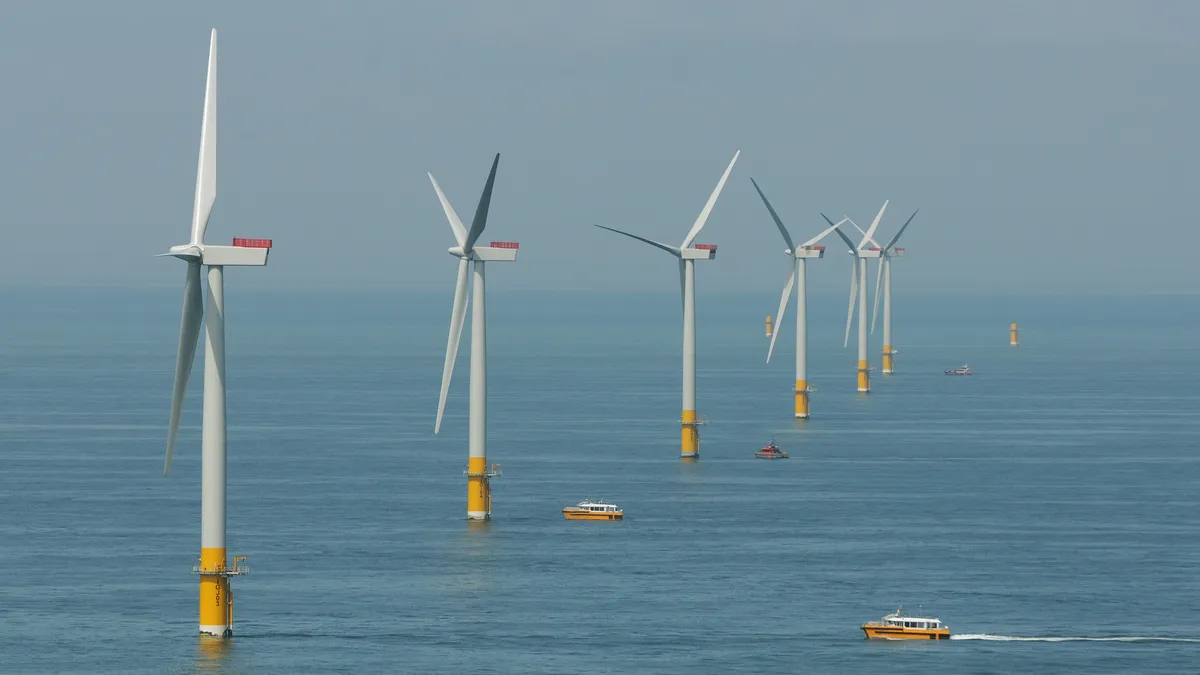Dive Brief:
- Clean energy groups urged California regulators to set bold offshore wind energy planning goals for the state at a California Energy Commission (CEC) workshop held Thursday.
- "Several decades of offshore wind industry experience and academic study have demonstrated conclusively that going big is one of the most important keys to achieving success with this remarkable clean energy technology in California and other U.S. and global markets," Adam Stern, executive director of Offshore Wind California, said at the meeting.
- Last year, California lawmakers passed Assembly Bill 525, which instructed the CEC to quantify "the maximum feasible capacity of offshore wind to achieve reliability, ratepayer, employment, and decarbonization benefits," as well as create 2030 and 2045 offshore wind planning goals for the state by this June.
Dive Insight:
The Biden administration is aiming to deploy 30 GW of offshore wind across the country by 2030, eventually ramping up to 110 GW by 2050. Last May, the administration announced an effort to bring as much as 4.6 GW of floating offshore wind online in the Western Outer Continental Shelf. Building 10 GW of offshore wind off the coast of California could lead to resource cost savings of around $1 billion, reduce 4.73 million metric tons of carbon dioxide equivalent by 2040, and generate tens of thousands of jobs, according to a report released by the University of Southern California Schwarzenegger Institute for State and Global Policy in September.
Along with establishing the planning goals, AB 525 requires the energy commission to develop a strategic plan to develop offshore wind in federal waters off the California coast, to be submitted to the state legislature by June of 2023. The plan will need to identify suitable seaspace for the resource, as well as look into the transmission that would be needed to meet the new goals, and outline permitting timelines to get offshore wind up and running.
At the CEC workshop on Thursday, clean energy advocates outlined potential goals that they believe regulators should adopt. Many urged the commission to look at ambitious targets to develop economies of scale.
"For offshore wind, economies of scale will be essential for driving down costs, delivering competitively priced clean power and encouraging industries and jobs to locate in our state," Offshore Wind California's Stern said.
The organization urged the commission to consider a goal of generating at least 3 GW of offshore wind by 2030, 10 GW by 2040 and 20 GW by the middle of the century – figures that Stern said would align well with the Biden administration's national goal of 110 GW by 2050.
The American Clean Power Association's California branch also encouraged the state to establish ambitious goals for offshore wind planning – including a 3 GW goal by 2030 and 18 GW goal by 2045 – to help incentivize the industry, create a supply chain, and spur offshore wind jobs, according to Varner Seaman, the branch's offshore wind program director.
Environment California, a statewide advocacy group, meanwhile, pushed for a goal of at least 10 GW of offshore wind development by 2040.
"One of the best clean energy sources in California is the wind blowing off our coast, where the wind blows faster and harder than anywhere else in the U.S.," Ben Grundy, the group's global warming solutions campaign associate, said at the workshop.
But while she agreed that the state should set installation targets high enough to drive economies of scale and support a domestic supply chain, "we need a reality check," said Nancy Rader, executive director of the California Wind Energy Association.
"The recent East Coast auctions have been successful because the fixed bottom technology is proven and available and there was much greater certainty than we have in California right now, including commitments for power offtake and available port space," Rader said.
The state's ambitious goals will need to be coupled with careful plans and near-term decisions to support the investments that will be needed to ensure the supply chain and jobs tied to floating offshore wind platforms in California, Rader added. This includes establishing greater market certainty by creating a power offtake plan this year for demonstration and commercial projects, as well as making progress towards CAISO's 20-year conceptual transmission plan.















